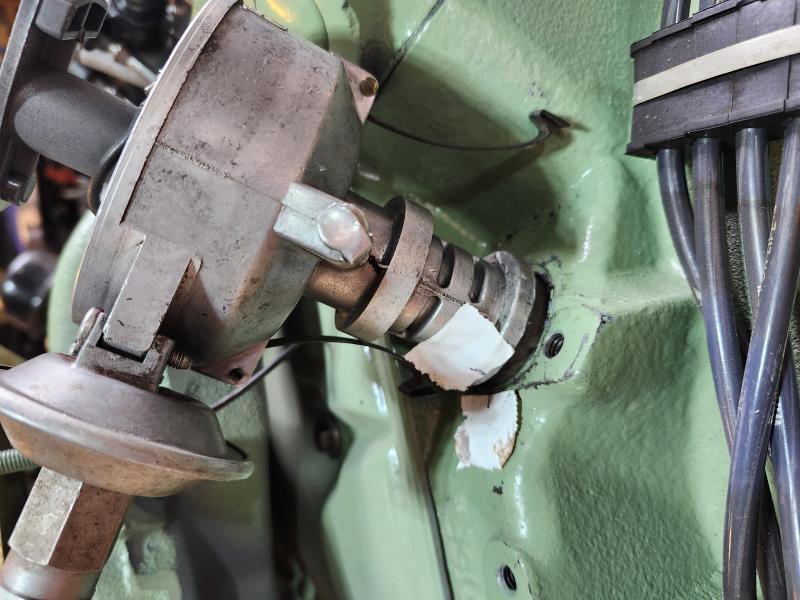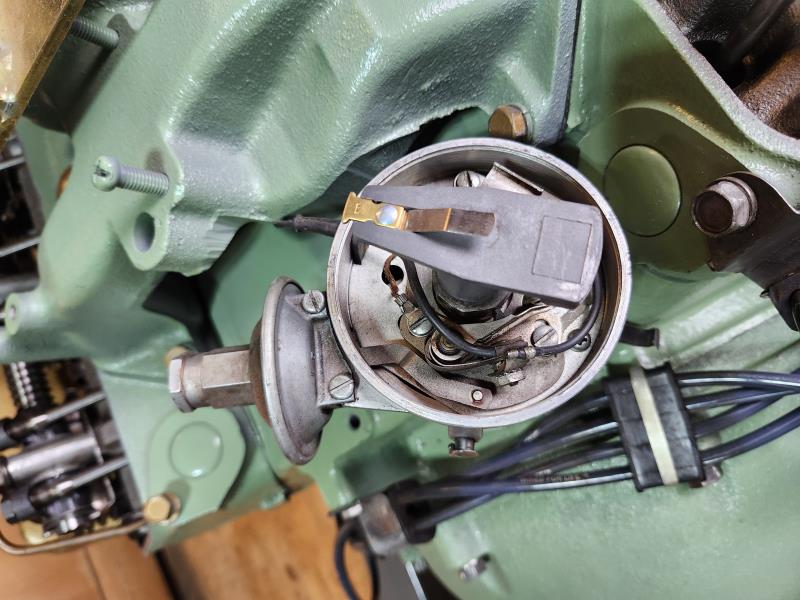|
Author
|
Message
|
|
Ted
|
|
|
Group: Administrators
Last Active: Yesterday
Posts: 7.5K,
Visits: 205.8K
|
B-rad (6/1/2025)
This is as far as it wants to drop in. What do I need to do to get it down all the way?Once you get the distributor in place but it does sit squarely on the block yet due to the oil pump shaft not being in the correct orientation, you will need to bump or turn the engine over slowly until the distributor completely drops in place. You may need to put a light downward pressure on the distributor housing while rotating the engine to make this happen as gravity alone may not do it for you. Once the distributor has dropped all the way down, then you can double check that rotor is indeed still pointing to #1 in the cap with the damper at 20-25° BTDC.
  Lorena, Texas (South of Waco) Lorena, Texas (South of Waco)
|
|
|
|
|
B-rad
|
|
|
Group: Forum Members
Last Active: Last Month
Posts: 348,
Visits: 1.5K
|
This is as far as it wants to drop in. What do I need to do to get it down all the way?   Brad
Brad
Sierra Vista Arizona
1954 Lincoln Capri
|
|
|
|
|
KULTULZ
|
|
|
Group: Forum Members
Last Active: 3 days ago
Posts: 1.8K,
Visits: 306.3K
|
Well, I would turn the engine over by hand until I heard compression being released and then back it off before inserting the piston stop. I know what you are thinking and I realize you are much more experienced than I am but I would be concerned about the quality of the assembly work of the shop he had it in. I would just simply verify the timing(s) are correct before hitting it with the starter motor (and then watch the oil pressure gauge very closely). I am not dogging anyone, just here to learn and I have learned a lot on this forum. BTW - I am OCD (CDO in correct alphabetical order) ... 
____________________________
|
|
|
|
|
Hoosier Hurricane
|
|
|
Group: Moderators
Last Active: 3 hours ago
Posts: 3.7K,
Visits: 323.0K
|
Kultulz, how do you know with a piston stop whether the piston is on compression or overlap mode?
John - "The Hoosier Hurricane"

|
|
|
|
|
KULTULZ
|
|
|
Group: Forum Members
Last Active: 3 days ago
Posts: 1.8K,
Visits: 306.3K
|
I think it is important to use a piston stop to determine correct #1 TDC on fire. It will also ensure the damper is indexed correctly and cam/ign timing is correct. If you know for certain (no doubt in your military mind) that all of this is correct, then you would use the shortcuts (IMO). This is a fresh build.
____________________________
|
|
|
|
|
Ted
|
|
|
Group: Administrators
Last Active: Yesterday
Posts: 7.5K,
Visits: 205.8K
|
Not having a LYB engine here to look at, I’m going to say that the #6 exhaust valve is the 4th valve from the front. The #6 intake valve will be the 3rd valve from the front. Verification of this is the exhaust valve will be in line with the exhaust port. When the valves are moving as the engine is rotated clockwise as looking from the front, the exhaust valve will be the first to move and then followed by the intake valve. As John mentions, as the #6 exhaust valve is just closing (coming up) and the #6 intake valve just starts opening (going down), the damper should be close to reading TDC. That will be #1 compression and where you want to drop the distributor in for #1 cylinder timing purposes.
  Lorena, Texas (South of Waco) Lorena, Texas (South of Waco)
|
|
|
|
|
B-rad
|
|
|
Group: Forum Members
Last Active: Last Month
Posts: 348,
Visits: 1.5K
|
Which one is the exhaust valve
Brad
Sierra Vista Arizona
1954 Lincoln Capri
|
|
|
|
|
Hoosier Hurricane
|
|
|
Group: Moderators
Last Active: 3 hours ago
Posts: 3.7K,
Visits: 323.0K
|
Take the left rocker cover off. Turn the crank and watch the #6 exhaust valve. When the valve begins to close, as it nears almost closed the intake valve will just begin to open. At this point the timing mark should be at or near zero. Number one piston is now at the top of the compression stroke. You can now proceed with the distributor installation with the rotor pointing to the #1 plug wire.
John - "The Hoosier Hurricane"

|
|
|
|
|
B-rad
|
|
|
Group: Forum Members
Last Active: Last Month
Posts: 348,
Visits: 1.5K
|
Im putting my finger over the no 1 plug hole and I turn the crank clockwise around the tdc mark and instead of feeling my finger being pushed out i feel a slight sucking. I'm using a breaker bar so I can't move it a whole lot at a time. Is there another way to verify the no 1 piston is in the correct position besides this method?
Brad
Sierra Vista Arizona
1954 Lincoln Capri
|
|
|
|
|
Ted
|
|
|
Group: Administrators
Last Active: Yesterday
Posts: 7.5K,
Visits: 205.8K
|
DANIEL TINDER (5/26/2025)
Ted (5/25/2025)
Even dead stock engines are typically factory timed to some degree value that is BTDC. By the same token, a first start for any engine should always have a liberal amount of ignition advance before TDC to ensure an easy start. I have found that 25° BTDC for the first fire up will guarantee an easy start. As a general rule, that extra bit of ignition advance does not need much correction once the engine is fired up and the actual timing is set. Having some extra ignition advance on the startup will not hurt the engine and in most instances will have the engine running cooler for that initial camshaft break in period.
With all that being said, he’s a link to a past thread on the subject.http://forums.y-blocksforever.com/FindPost138330.aspx
Ted,
Re-reading your 2018 reply, concerning startup advance ‘leeway’, and ‘low’ compression’:
Would you likely consider your 20 degree BTDC recommendation a maximum with 10:1 static in a fresh rebuild (Isky E-4/centered)? That would be a No. 25° BTDC for an initial start is not a problem for most engines. The 13.0:1 compression in my Y powered roadster starts just fine at 26° BTDC even when heat soaked. You must keep in mind that when both the mechanical and vacuum portions of the distributor are maxed out in certain driving conditions, you are potentially looking at well over 50° BTDC on many of your stock engines.
  Lorena, Texas (South of Waco) Lorena, Texas (South of Waco)
|
|
|
|